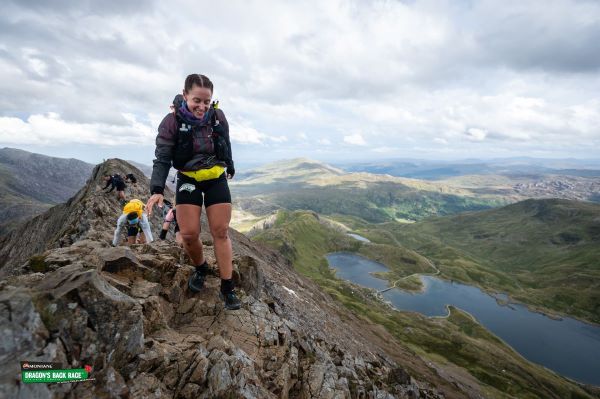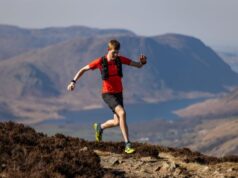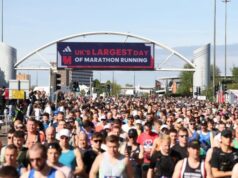For many runners, foot health only becomes a priority when problems arise. Endurance runners Simon Dent and Sophie Bennett are on a mission to shift this perspective. As guests on the UKRunChat podcast, they shared their insights and experiences to inspire runners to give their feet the attention they deserve.
Simon Dent, a relative latecomer to ultra-running, launched Save Our Souls at the start of 2025 after experiencing first-hand the challenges of foot care during endurance events. Simon’s journey into running began in 2018, and since then he has completed around 20 ultra-marathons. A pivotal moment in his journey was the Marathon des Sables in 2023, a gruelling multi-day race in the desert renowned for its harsh conditions and emphasis on foot care.
“There were 25 specialist foot doctors following us around the desert,” Simon shared. This experience highlighted the importance of foot health and inspired him to create a brand and community to address the lack of resources, advice, and products for runners.
Why foot health should be your top priority as a runner
Sophie Bennett, a seasoned endurance athlete, has first-hand experience with the toll that long races can take on feet. She recalls her first Dragon’s Back Race, a demanding multi-day event across rugged terrain in Wales, as a turning point in her understanding of foot care.
“I researched a lot about feet before the race, but there wasn’t much information available beyond the classic ‘Fixing Your Feet’ book,” Sophie explained. The pain and challenges she endured during that event underscored the need for more accessible resources and solutions.
“Running and foot health are two of my passions. Without my feet, I wouldn’t have experienced half the incredible places or completed the challenges I’ve been lucky enough to do,” she said.
“I had seven days of pain at the Tor des Géants. I mean, I look after my feet, and I still went through that pain,” she shared. For races that demand being on one’s feet for up to 150 hours, Sophie acknowledges that some discomfort is inevitable.
Her meticulous routine includes regular visits to a podiatrist, especially before major races, as well as pre-race preparations like filing calluses and taping her feet. During races, she changes socks, dries her feet at every opportunity, and re-applies tape as needed.
Despite her diligent care, Sophie recounted the harsh realities of ultra-endurance racing. From enduring infections to having toenails pierced to relieve pressure.
As part of their research, the Save Our Souls team collaborated with podiatrists and chiropodists, who echoed a common concern: most runners don’t prioritise foot care until their 40s or 50s, often after years of accumulated damage. “It’s incredibly difficult to reverse 20 or 30 years of neglect,” Simon explained.
Traditional foot care marketing often fails to resonate with younger, active individuals. “A lot of foot care brands have been around since the 1950s, and their marketing reflects that: think corn pads and blister plasters marketed to a 70-year-old in a chair. That’s not appealing to our community,” he said.
Simon cited research showing that feet are one of the least visible body parts, both physically and mentally. “You rarely see your feet, and they’re so far from your face and eyes that they’re easy to forget,” he explained.
This detachment leads many runners to overlook foot discomfort until it becomes a bigger issue. “The everyday runner probably ends up with blisters because they ignore their foot problems,” Simon noted.
Preventing blisters: tips for runners
One of the most common issues faced by runners is blisters. Sophie Bennett shared her practical advice on managing blisters during long runs and races, stressing the importance of proactive care.
“Address it the moment you feel a hotspot,” Sophie emphasised. Hotspots, the early warning signs of a blister, require immediate attention.
Sophie underscored the importance of preparation, recommending that every runner carry a comprehensive first aid kit during their runs. Her own kit includes essentials like gauze, kinesiology tape, and a small blade.
To pop, or not to pop?
For Sophie, dealing with a blister involves carefully managing it to prevent further damage. “If a blister has already formed, I carry a blade to ease it off. I’ll then apply some gauze and tape it up with k-tape,” she explained. “The goal is to release the pressure, protect it, and prevent infection.”
Ignoring blisters is not an option, she warned. “If you leave them, they’re only going to get worse during your run. Addressing them immediately is crucial to keeping your feet in good condition and minimising long-term discomfort.”
Simon and Sophie both agree that awareness is critical. “It’s not just about being prepared; it’s about knowing your feet and recognising when something’s wrong,” Sophie said. Proactively addressing issues like blisters can make a significant difference in comfort and performance.
Practical steps for blister care
- Carry a blister kit: Include gauze, kinesiology tape, antiseptic wipes, and a small blade in your first aid kit.
- Act quickly: Address hotspots as soon as you notice them.
- Release pressure: If a blister forms, carefully drain it with a sterilised blade to relieve discomfort.
- Protect the area: Cover the blister with gauze and secure it with K-Tape to prevent further irritation or infection.
- Stay vigilant: Check your feet regularly during long runs to catch potential problems early.
Preventing common foot issues in runners
Ingrown toenails
“Once ingrown toenails reach a certain stage, they’re not something you can easily treat at home,” said Simon. “Trying to manage them yourself often does more harm than good.”
Sophie recommends regular appointments with a podiatrist as an essential investment:
“Runners will spend hundreds on new trainers and kit but often skip the podiatrist. It’s such a vital step: if your feet are in poor condition, they can end your race. For men who might hesitate about something like a pedicure, think of it as essential maintenance for your running performance.
“Make sure your nails are trimmed and not getting battered against the end of your trainers,” she advised.
Foot fungus
Foot fungus, particularly athlete’s foot, thrives in the warm, damp environment of sweaty trainers.
Simon emphasised the importance of proper shoe care: “Your damp, dark trainers are a breeding ground for bacteria. If you finish a run, throw your damp trainers into a warm cupboard, and don’t dry them properly, bacteria will flourish, and that can easily transfer to your feet.” Use tools like shoe dryers or air them out after every run.
Foot care strategies for extreme conditions: racing in the desert vs. wet conditions
Simon shared insights into the challenges of foot care during extreme races like the Marathon des Sables, highlighting how preparation and proactive care are critical in such harsh environments.
“In the desert, temperatures can reach 50 degrees Celsius, so sweating becomes a massive issue,” Simon explained. Sweat, combined with sand and dust, creates the perfect storm for blisters and irritation.
To combat this, runners take several precautions:
- Taping feet daily: Proper taping helps prevent hotspots and blisters, which are almost inevitable in such conditions.
- Gaiters: These are essential to stop sand and fine dust from getting into shoes and causing abrasions.
- Shoe sizing: Simon noted, “Everyone was advised to go at least one size up because feet swell significantly in the heat. But this presents its own challenges—training one size up in the UK isn’t practical unless you layer multiple socks, which comes with its own issues.”
Even with meticulous preparation, Simon found the desert environment tough on his feet: “By the time I got home, my feet were barely recognizable, and I was one of the lucky ones. The injuries some runners sustained were extreme.”
Simon has since implemented strategies from the Marathon des Sables into his regular running routine. “Double socks are something I started using after the desert,” he shared. For example, in his upcoming backyard ultra, he planned to wear a pair of toe socks layered under regular socks. “I’ve found that works really well for me.”
The heat of the desert and the challenges of running through wet conditions on moorland or bogs take a completely different approach to foot care. Simon explained: “In wet environments, the focus shifts to preventing prolonged moisture exposure, which can cause maceration and blisters. But the principle is the same: as soon as you feel discomfort, stop and address it.”
Post-race foot recovery
Sophie reflected on the state of her feet after her most recent races, admitting that they were often too painful to touch immediately after finishing. She explained her recovery process: “As soon as I can, I focus on ensuring there’s no infection spreading and just giving my feet the care they need. That includes waiting for toenails to drop off, avoiding wearing trainers for a while, and eventually getting back into a routine of proper foot maintenance.” This routine, she elaborated, includes trimming nails, exfoliating dead skin, and occasionally seeking professional help to keep her feet in good condition.
Simon chimed in with additional advice, agreeing with Sophie’s point that everyone’s feet are different and require individual care. “Some people need double socks, others don’t. Some need taping, some don’t. You’ve got to find what works for you, and that takes experimenting during training, not on race day,” he said.
Both runners emphasised the importance of being proactive about foot care. “Your feet can make or break your race,” Sophie noted, “so take the time to research, try different methods, and find what works for you.”
Sophie added: “People don’t talk about their feet until they’re suffering.” She encouraged a shift in focus: “Instead of sharing horror stories of wrecked feet, let’s highlight examples of healthy feet that have been well cared for and are ready to tackle the race.”
Foot care is not just for trail and ultra runners
Both runners highlighted that foot health is a universal concern, not just for trail runners or those covering long distances. For road runners and those running shorter distances, Simon stressed the importance of proper shoe selection. He shared his journey of finding the right footwear, recounting how he initially got caught up in marketing trends and bought shoes that didn’t suit him. “Now, I proudly wear what works for me, even if it’s not what everyone else is wearing,” he said.
How to care for your running shoes
Simon shared his personal method for keeping his trainers in good condition, emphasising the importance of proper cleaning and drying techniques. “Whether that’s from a wet morning run in winter or dew from a summer’s morning, as soon as you get back, dry your trainers properly because they’ll be good to go tomorrow,” Simon explained.
Sophie agreed, noting her preference for washing trainers by hand. “I wash my trainers every time they’ve been muddy,” she said, adding that she avoids using a washing machine. Instead, she cleans them in the sink and stuffs them with newspaper to help them dry. However, she acknowledged the challenge of ensuring they dry thoroughly in time for the next run.
Simon highlighted the potential risks of improper drying, especially using radiators, which can damage the glue and materials in modern running shoes. “We’ve tested quite a lot of trainers, and unfortunately, drying them on a radiator can damage the material. That’s why our shoe dryer has been so beneficial: it protects the shoes and helps them last longer.”
Care for your feet, and they’ll care for you
Sophie and Simon hope their conversation inspires more runners to prioritise foot health. “Your feet are arguably the most important part of your race,” Sophie remarked, urging runners to avoid waiting until issues arise. Simon echoed this sentiment: “Don’t let your feet become an afterthought. Look after them now, and they’ll carry you far.”
Want to start prioritising foot care?






